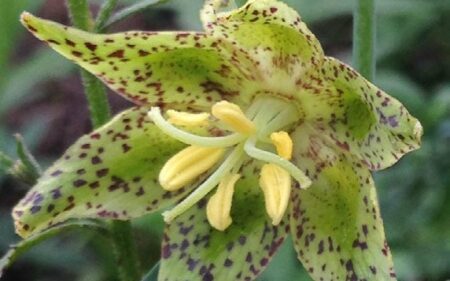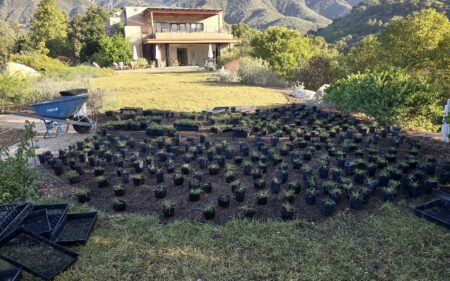That’s a Lot of Lichens
The Garden’s Conservation and Research department works to document California’s biodiversity and part of that work happens in its lichenarium.
Much of the Garden’s conservation and research efforts involve staff going into the field to observe living things in their natural habitats. However, there is another side of work that stays at the Garden. In the basement of the Pritzlaff Conservation Center, there is a museum containing thousands of plant and lichen collections from every continent. These collections provide important information about where and when organisms have existed across the landscape, and they can therefore inform many different aspects of research such as community ecology, land use changes, and climate change effects. The museum is made up of an herbarium, which is home to plant specimens, as well as a lichenarium, which is home to lichen collections. The lichenarium contains 35,500 lichens, which are each carefully enclosed in a packet or box. But, that number is about to change because the lichenarium has recently received a donation of 16,000 lichens from the University of California Riverside.
The Garden received a donation of lichens from the University of California Riverside, making the Garden’s lichenarium the largest collection of lichens in California.
The team in the lichenarium has been incorporating these new lichens into the current collection. That means that every single specimen, including the “old specimens” from the SBBG collection, is handled manually in order to add a barcode, make sure the scientific names are updated, and verify that the descriptive information on the packages is correctly entered in the online database. The work is expected to take a full year at least. Once it is complete, the data for every lichen specimen in the collection will be publicly available on the Consortium of North American Lichen Herbaria (CNALH). At that time, the lichenarium will contain around 51,000 individual lichen collections, making it the second-largest lichenarium in California.






What does it take to collect lichen specimens?
Unlike plants, the majority of lichens grow so closely attached to their surfaces that they can’t be removed from each other. To collect those specimens, researchers need to remove the lichen along with whatever it is growing on. For bark dwelling lichens, researchers use a knife to remove a thin outer layer of bark that supports the lichen. For rock dwelling lichens, researchers use a chisel and/or hammer to break off sections of rock with lichens growing on them. Once the lichen is collected, it is transferred to a box or envelope along with information about where it was collected. The specimen is stored in a lichenarium, where it serves as a record of a lichen occurrence in a particular place and time.
Over one third of all the lichen species in the United States can be found in California.
Despite such a huge number of collections, the Garden’s lichenarium doesn’t currently have a representative specimen of every lichen that can be found in California. There are over 2,000 species of lichens across California’s diverse landscapes, which makes up 36% of all lichens found in the United States. So, it’s important for lichenologists to continue to collect, identify, and deposit lichen collections in lichenariums. With continuous records of lichens, researchers can analyze how lichen biota has changed over time and space and thereby gain a better understanding of how living lichens respond to changes to the environment.
The lichenarium contains the oldest museum specimen in the Garden’s collections.
For example, the lichenarium is home to a lichen that was collected in 1843 in New Hampshire by Edward Tuckerman, who shaped North American lichenology. This lichen is the oldest collected specimen at the Garden. Even if the exact collection locality is not mentioned on this collection, at least we know that Rinodina lichen (Rinodina ascociscana) occurred in the White Mountains in New Hampshire almost 200 years ago.


 Donate
Donate




